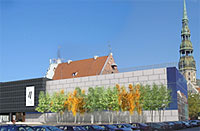Let there be LIGHT
 The Museum of the
Occupation of Latvia is housed in a building first built as the
Latvian Red Riflemen's Museum. The Latvian Riflemen's battalions and
regiments were national fighting units within the Czarist Russian
army. They were formed in 1915 and sent to fight against the invading
German army threatening Riga. In late 1917, after the Germans
occupied Riga, they sided with Lenin's revolution because Lenin had
promised national liberation from the "prison of nations"
as he called Czarist Russia. Many of the fighters who survived and
remained in Soviet Russia after the revolution, were killed during
Stalin's purges of 1937 and 1938.
The Museum of the
Occupation of Latvia is housed in a building first built as the
Latvian Red Riflemen's Museum. The Latvian Riflemen's battalions and
regiments were national fighting units within the Czarist Russian
army. They were formed in 1915 and sent to fight against the invading
German army threatening Riga. In late 1917, after the Germans
occupied Riga, they sided with Lenin's revolution because Lenin had
promised national liberation from the "prison of nations"
as he called Czarist Russia. Many of the fighters who survived and
remained in Soviet Russia after the revolution, were killed during
Stalin's purges of 1937 and 1938.
The architect of the building is Gunars Lusis-Grinbergs. Covered with shining copper – initially glowing reddish-orange, which has since blackened, was designed in the "brutalism" style popular in Soviet times. The cobble stones around the building were selected to be red granite only. The Museum opened in a solemn ceremony on Lenin's 100th birthday, the 22nd of April 1970. The museum served as an exhibition hall, documenting the battles of the Red Riflemen and also as an educational and ceremonial place for the communist youth organization - the Pioneers.
The square in front of the building facing the Daugava River is still called the Riflemen's Square. In 1971 a large red granite statue of three soldiers, WWI Riflemen, was erected next to the museum building.
The Red Riflemen's museum was closed in the early 1990's and the Occupation Museum opened in the building on the1st July,1993.
In 1999, the Riga City Council, housed opposite the Museum, tried hard to make communism and anything symbolizing the Soviet era disappear. The building occupying the Occupation Museum was earmarked to be bulldozed. What ensued was a battle between politicians and historians and architects. To remember or to forget the Soviet Union? That was the question. In contrast the 14th Century House of Blackheads, a symbol of German occupation, its facade destroyed in 1941 and in 1953 the Soviets blew up the remnants, was pristinely rebuilt and restored. The reconstruction costing 7 million euros.
The historians and architects won the debate and the Occupation Museum is here to stay with a 1 million dollar expansion project. The new project's architect is internationally acclaimed Latvian-American architect, Gunars Birkerts, who also designed the new Latvian National Library.
When asked about what he thought about the original building and its history, Gunars stated the following "For the design of the extension I took into consideration the personality of the building and its history. The original building is a remnant of the Soviet era, expressive of it's time. It is architecturally important as a symbol of that particular period. These images should not be destroyed as we have outlived that era and there is no danger of it being anything but symbolic."
Gunars was traveling to Riga for his Library project and was aware of the Occupation Museums plight for destruction and all the indecision surrounding it. He came to them with the solution, at no charge, an addition to house essential office and archive storage space that was aesthetically pleasing and a positive symbol of Latvia today. "The original building is sinister, a black armored cell. I have created a new image, of opposite imagery, white, transparent and light. I have used a minimalist approach with a sense of crystalline transparency. The extension is expressive of the new Latvia, an open, reborn country." says Gunars.
The building and
land have now been returned to the Latvian government, first stages
plans have been completed and Gundega Michel, the museums director,
hopes that construction will be completed by mid 2010. "The
building's renovation will be financed by the state. The Museum is
conducting a major fundraising campaign to provide the new building
with furniture and equipment and to build a new permanent
exhibition." Said Gundega.
"No, there are no plans to polish
the copper exterior - it seems quite appropriate that the "red"
building is now essentially black - and slowly turning green !"
By Larisa Medene




